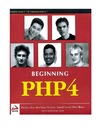PHP is a server-side scripting language. It is an open source, cross platform technology (NT, Linux, UNIX), rapidly gaining popularity as a scripting language for people running dynamic websites. Using practical examples and a step by step approach, this book explains how to develop web applications using PHP.
Amazon.com Review Beginning PHP4 offers an almost ideal introductory tutorial to one of today's hotter scripting languages. This book really is everything that the novice needs to start building dynamic Web sites that are powered by PHP4, but old hands at programming also will find in it valuable information.
PHP, of course, is introduced in the book, but there's also an approachable and effective introduction to programming in general. The conscientious tutorial on basic concepts like variables, keywords, and flow control will give even beginners an understanding of the basics of writing programs. PHP, it turns out, is not only a great way to generate HTML dynamically, but a very marketable skill. Web fundamentals like HTTP, HTML form variables, and managing session information using no less than four different techniques are explained thoroughly and effectively. You also find out how to install PHP and other tools on your system, with the assistance of plenty of screen shots.
That's not to say that this book will cramp the style of more experienced developers. Some chapters delve into such important and advanced topics as database programming (with MySQL) and PHP's support for XML. One standout section demystifies the new support for objects and classes in PHP4. Basic topics like managing files and directories on the server, plus graphics processing, are addressed, of course, and a nifty sample program shows you how to build a Web-based text editor. Except for the final case study — a "URL directory manager" (akin to Yahoo!) that's rather specialized — the examples are right on, and illustrate everyday programming tasks. You'll learn also how to generate e-mail with PHP — certainly a valuable skill to have.
The appendix lists several hundred PHP functions in over 50 pages — a handy and useful feature. In all, Beginning PHP4 provides a strong choice for learning about one of today's most powerful and easy-to-use scripting languages; it's concise, fast moving, and thoroughly approachable. — Richard Dragan
Topics covered:
- Introduction to PHP 4
- Downloading and installing PHP
- Basics of HTTP and Web pages
- PHP as a scripting language
- PHP data types
- Constants and conversions
- HTML primer
- Form variables
- Decision making in PHP
- Loops and arrays
- PHP functions
- Error handling in PHP
- Tips on writing more maintainable code
- Debugging hints
- Preserving state with hidden form variables
| | - Query strings
- Cookies and PHP4 native sessions
- Using PHP objects
- File and directory functions
- PHP database programming
- Installing and using MySQL
- Tutorial for SQL syntax
- Querying and updating records
- XML "quickstart" for PHP users
- Creating e-mail and electronic newsletters
- PHP graphics processing (including image maps)
- Case study for a URL directory manager
- ODBC tutorial
- PHP4 function reference
| |
 |
|
О проекте
|
|
О проекте


